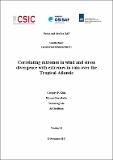Por favor, use este identificador para citar o enlazar a este item:
http://hdl.handle.net/10261/158566COMPARTIR / EXPORTAR:
 SHARE
BASE SHARE
BASE
|
|
| Visualizar otros formatos: MARC | Dublin Core | RDF | ORE | MODS | METS | DIDL | DATACITE | |

| Título: | Correlating extremes in wind and stress divergence with extremes in rain over the Tropical Atlantic |
Autor: | King, Gregory P. CSIC ORCID; Portabella, Marcos CSIC ORCID ; Lin, Wenming CSIC ORCID; Stoffelen, Ad | Fecha de publicación: | 13-nov-2017 | Citación: | Ocean and Sea Ice SAF Scientific Report 312: 1-35 (2017) | Serie: | SAF/OSI/CDOP3/KNMI/SCI/RP/313 (2017) | Resumen: | Air-sea fluxes are greatly enhanced by the winds and wind structures generated by Mesoscale Convective Systems (MCSs). In contrast to global numerical weather prediction models, space-borne scatterometers are able to resolve the small-scale wind variability in and near MCSs. Heavy rain events (rain bursts) occurring in MCSs produce strong gusts and large divergence and curl in surface winds. In this report wind fields from the ASCAT-A and ASCAT-B tandem mission, collocated with Meteosat Second Generation rain fields, were used to develop a methodology capable of identifying and quantifying correlations between wind and rain. Categories of wind divergence, wind stress divergence, and rainfall intensity were defined and a spatial neighbourhood spanning a 25km-by-25km block of WVCs was searched to identify coincidences of extreme rain and extreme convergence/divergence.This showed that when there is extreme rain, there is extreme convergence/divergence in the vicinity. The coincidences were tabulated in 3-by-3 and 2-by-2 contingency tables from which cross-correlations were calculated for each time step in the collocation. The resulting response curves for extreme convergence and extreme divergence each had a well-defined peak. The time lag for the convergence peak was 30 minutes, implying that extreme rain generally appears after (lags) extreme convergence. The overall conclusion then is that the temporal scale of moist convection is determined by the slower updraft process. Results for wind divergence and wind stress were qualitatively similar, wind stress divergence showing the stronger response. This is probably due to its focus on high winds. The report also notes that extreme convergence/divergence are concentrated in spatial patches and recommends for further study to relate the spatial features with the statistics, and as a focus for studying the changes in the divergence fields between the ASCAT-A and ASCAT-B passes | Descripción: | 35 pages, 18 figures | URI: | http://hdl.handle.net/10261/158566 |
| Aparece en las colecciones: | (ICM) Informes y documentos de trabajo |
Ficheros en este ítem:
| Fichero | Descripción | Tamaño | Formato | |
|---|---|---|---|---|
| King_et_al_2017.pdf | 4,34 MB | Adobe PDF |  Visualizar/Abrir |
CORE Recommender
Page view(s)
284
checked on 23-abr-2024
Download(s)
405
checked on 23-abr-2024
Google ScholarTM
Check
NOTA: Los ítems de Digital.CSIC están protegidos por copyright, con todos los derechos reservados, a menos que se indique lo contrario.
